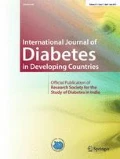Abstract
The aim of this study was to examine the frequency of Cushing’s syndrome (CS) in obese type 2 diabetic patients devoid of specific clinical symptoms of Cushing’s syndrome. A total of 148 obese (BMI ≥30 kg/m2 ) type 2 diabetic patients (113 female, 35 male) were included in the study. An overnight 1-mg dexamethasone suppression test (DST) was performed on all patients. Suppression of serum cortisol to <1.8 μg/dL after administration of 1 mg dexamethasone was considered normal suppression. Low dose dexamethasone suppression test was performed on the patients who had serum cortisol level over 1.8 μg/dL after overnight 1 mg DST. Regression analysis was applied to determine the effective factors on suppression of serum cortisol. Mean age, BMI and HbA1c levels respectively were 50,82 ± 8,50 year, 31,78 ± 4,66 kg/m2, %8,96 ± 2,42 in males and 54,15 ± 10,348 year, 34,32 ± 5.71 kg/m2, % 8,18 ± 2,06 in females. Serum cortisol level was found 1.64 ± 5.62 μg/dl after overnight DST. A total of 9 (6.2 %) patients had non-suppressible overnight DST. Only four (2.6 %) of these patients were diagnosed with Cushing Syndrome after low-dose DST. Diagnosis was confirmed pathologically. Etiologic reasons for Cushing’s syndrome were pituitary microadenoma (2 patients) and adrenocortical adenoma (2 patients). Age and duration of diabetes was found to be related to the degree of suppression. Cushing’s syndrome should be investigated in high-risk groups like uncontrolled diabetes, obesity. All the related factors on the degree of suppression must be considered for the final diagnosis.
Similar content being viewed by others
References
Kahn CR, Weir GC, King GL, Jacobson AM, Moses AC, Smith RJ. Joslin’s Diabetes Mellitus. 14th ed. Boston: Lippincott Williams-Wilkins; 2005.
Khan R. Weight gain and insulin therapy. Br J Diabetes Vasc Dis. 2004;4:264–7.
Kuczmarski RJ, Flegal KM, Campbell SM, Johnson CL. Increasing prevalance of overweight among US adults: The National Health and Nutrition Examination Surveys, 1960 to 1991. JAMA. 1994;272:205–11.
De Groot LJ, editor. Endocrinology. 5th ed. Philadelphia: WB Saunders; 2001.
Garrapa GG, Pantanetti P, Arnaldi G, Mantero F, Faloia E. Body composition and metabolic features in women with adrenal incidentaloma or Cushing’s syndrome. J Clin Endocrinol Metab. 2001;86:5301–6.
Douyon L, Schteingart DE. Effect of obesity and starvation on thyroid hormone, growth hormone, and cortisol secretion. Endocrinol Metab Clin North Am. 2002;31:173–89.
Catargi B, Rigalleau V, Poussin A, Ronci-Chaix N, Bex V, Vergot N, et al. Occult Cushing’s syndrome in type-2 ciabetes. J Clin Endocrinol Metab. 2003;12:5808–13.
Tabarin A, Perez P. Pros and cons of screening for occult Cushing syndrome. Nat Rev Endocrinol. 2011;7:445–55.
Caetano MS, Silva Rdo C, Kater CE. Increased diagnostic probability of subclinical Cushing’s syndrome in a population sample of overweight adult patients with type 2 diabetes mellitus. Arq Bras Endocrinol Metabol. 2007;51:1118–27.
Reimondo G, Pia A, Allasino B, Tassone F, Bovio S, Borretta G, et al. Screening of Cushing’s syndrome in adult patients with newly diagnosed diabetes mellitus. Clin Endocrinol. 2007;67:225–9.
Christy NP. Harvey Cushing as clinical investigator and laboratory worker. Am J Med Sci. 1981;281:79–96.
Yanovski JA, Cutler Jr GB. Glucocorticoid action and the clinical features of Cushing’s syndrome. Endocrinol Metab Clin North Am. 1994;23:487–509.
Leibowitz G, Tsur A, Chayen SD, et al. Preclinical Cushing’s syndrome: an unexpected frequent cause of poor glycemic control in obese diabetic patients. Clin Endocrinol (Oxf). 1996;44:717–22.
Tiryakioglu O,Ugurlu S, Yalin S, Yirmibescik S, Caglar E, Yetkin DO et al. Screening for Cushing's syndrome in obese patients. Clinics 2010. http://dx.doi.org/10.1590/S1807-59322010000100003.
Baid SK, Rubino D, Sinaii N, Ramsey S, Frank A, Nieman LK. Specificity of screening tests for Cushing’s syndrome in an overweight and obese population. J Clin Endocrinol Metab. 2009;94:3857–64.
Ness-Abramof R, Nabriski D, Apovian CM, Niven M, Weiss E, Shapiro MS, et al. Overnight dexamethasone suppression test: a reliable screen for Cushing's syndrome in the obese. Obes Res. 2002;10:1217–21.
Sahin M, Kebapcilar L, Taslipinar A, Azal O, Ozgurtas T, Corakci A, et al. Comparison of 1 mg and 2 mg overnight dexamethasone suppression tests for the screening of Cushing's syndrome in obese patients. Intern Med. 2009;48:33–9.
Conflict of interest
None
Author information
Authors and Affiliations
Corresponding author
Rights and permissions
About this article
Cite this article
Mert, M., Temizel, M., Erol, S. et al. Screening for Cushing’s syndrome in obese type 2 diabetic patients and the predictive factors on the degree of serum cortisol suppression. Int J Diabetes Dev Ctries 32, 199–202 (2012). https://doi.org/10.1007/s13410-012-0091-1
Received:
Accepted:
Published:
Issue Date:
DOI: https://doi.org/10.1007/s13410-012-0091-1



